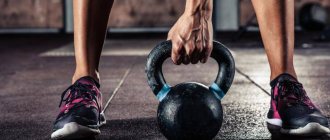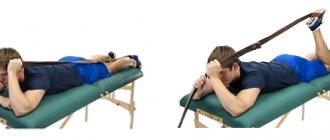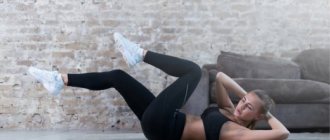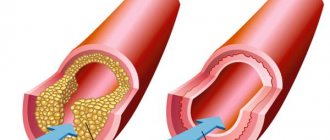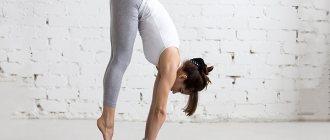Today, joint problems are familiar not only to older people. An inactive lifestyle, poor diet and lack of physical activity lead to pain in the back, neck and knees.
Simple joint gymnastics exercises will help restore freedom of movement and maintain the health of the musculoskeletal system.
Why do you need a warm-up?
First of all, in order to prepare the body for subsequent stress. Performing warm-up exercises allows you to maintain the health of your muscles and joints, warm up your muscles, and start metabolic processes. Therefore, it is necessary for both those who are gaining weight and those who are going to get rid of excess weight.
Expert opinion: Warming up increases the flow of fresh, oxygenated blood, increases blood pressure and speeds up the heart rate. Thus, a maximum supply of oxygen is created in the body, and it is needed in order to remove byproducts from working muscles [1].
You should start training after warming up. This will help improve your own results, protect the body from overload and reduce the risk of possible injuries while working on machines or with free weights.
Who will treat you: doctors from our clinic
Our center employs experienced kinesiotherapists who will create an individual program and monitor you during the treatment process and exercises in the gym. There is also the opportunity to exercise on simulators individually with a doctor.
If you are not a supporter of the constant use of medications and want to help your body activate its natural forces and recover on its own, then kinesitherapy is definitely for you!
We will be glad to see you in our center!
Olga Grigorievna Karpukhina, kinesiotherapist read more about the doctor
Achekeev Talant Kasymalievich kinesitherapist, reflexologist, anesthesiologist-reanimatologist read more about the doctor
Consequences of not warming up before exercise
If such motivation does not seem too clear (after all, during physical activity, the muscles will warm up in any case!), It is worth learning about what can happen to the body if you start exercising without proper preparation.
- Injuries to bone, muscle and connective tissue. In a “cold” state, the muscles harden and contract poorly, which is why they do not allow you to perform a good part of the usual exercises. If you pull them, you can get at least a spasm, and at most a sprain or tear.
- Joint diseases. When training without first working out all the joints, the risk of inflammation and deformation of the cartilage increases. Systematic loading will lead to decreased joint mobility, arthritis and arthrosis.
- Deformation of the ligamentous apparatus. “Cold” ligaments, like muscles, are inactive and prone to stiffening. Therefore, stress without warming up can easily injure fragile tissues.
What are the benefits of joint exercises?
The basis of musculoskeletal health is movement, so therapeutic exercises for joints are necessary for every person. The human body is designed for significant physical activity; without it, metabolism and blood circulation are disrupted, which causes joint pain. Regular exercise can achieve the following effects:
- Active production of joint fluid, which acts as a lubricant. A person becomes able to perform complex exercises, flexibility and mobility increases, pain and discomfort go away.
- Warming up the muscles. A set of exercises moves the muscles of the whole body, increasing mobility.
- Preparation for significant physical activity. Sets of exercises are great as a warm-up before more serious strength or cardio training.
- The concentration of salts, which are deposited on the joints and provoke the development of various diseases, decreases.
- There is a general positive effect on the human body: improved blood circulation, sufficient supply of oxygen and nutrients to the cells.
- After exercise, a person feels energized and invigorated.
- Hormonal levels stabilize and with regular exercise, they gradually return to normal.
The exercises are quite simple and accessible to everyone; you can do them yourself. Classes are recommended for people of any age, but before starting it is better to consult with your doctor. Regular exercise will strengthen the muscular skeleton, develop flexibility and mobility of joints, get rid of pain, start the process of cell regeneration, prevent the development of many diseases, improve the quality of life and overall well-being.
Warm-up features
It is better to start any workout with cardio. This is walking, running, jumping rope, cycling: in a word, any exercise aimed at warming up the body and increasing the pulse. At the same time, you need to start slowly and gradually: you shouldn’t break into a sprint, a light jog in place is enough, which can then turn into a full-fledged jog. You can determine that the warm-up has given the desired effect by sweating. As soon as the first sweat appears, it means that the body is warmed up and ready for stress. Don't forget about the cool-down: it needs to be done after training to work out the ligaments. The Herbalife 24 Recovery Cocktail can help reduce the risk of injury, saturate muscles with oxygen and speed up the process of gaining muscle mass. This product is designed specifically for athletes: it is recommended to use it within 20 minutes after intense exercise; the dosage is best selected individually, with the help of an experienced consultant.
Indications
Joint gymnastics is an excellent option for patients undergoing rehabilitation after treatment of diseases of cartilage tissue, operations on the knee, elbow, and hip joints. In addition, a set of exercises is needed for prevention by the following persons:
- after 40 years,
- women after childbirth,
- people leading a sedentary lifestyle,
- athletes, dancers, gymnasts experiencing increased physical activity,
- people who spend most of their time on their feet.
Warm-up exercises
You can choose the load based on the location of the deployment. For example, warming up before a home workout for girls may include running in place, jumping rope, and hula hooping. The same exercises as women are suitable for men, as well as exercises on steppers, treadmills, and bicycles. The principle of warming up is quite simple: start at a slow pace and gradually increase speed, monitoring your heart rate. It is best to exercise at a frequency of 120–130 beats per minute. Special fitness bracelets will help you monitor your heartbeat. You can spend 5-10 minutes doing cardio exercises before your main workout until you feel that your body is ready for more thorough and serious exercise. However, even this may not be enough. If you are working out at home, spend another 15-20 minutes warming up, alternately working out different areas of the body. We have selected for you simple and effective ways to warm up your muscles.
Neck
. Perform head turns and head-to-shoulder tilts 5-10 times on each side. Please note that movements should be as smooth and careful as possible: otherwise you may damage the ligaments. Additionally, describe a semicircle with your chin in a horizontal plane 5–10 times in each direction. Working out the neck muscles is very important: it can help strengthen blood vessels, improve cognitive abilities and memory.
Shoulder girdle
. Move your shoulders up and down, making sure that only they are working, isolating your shoulder blades and elbows. Then perform circular movements back and forth. Only the shoulders should work. Move smoothly, feeling your muscles stretch and warm up. Exercises are performed 10–15 times in each direction. Raise your right hand in front of you, grab your elbow and begin to pull it to the left. Do the same with the other hand. This exercise will help work out the muscles and ligaments and warm up the shoulder joint.
Hands
. Swing up and down and left and right. The movements are confident, but not too sharp. When moving your arms back, try to connect your shoulder blades. Then bend your elbows and rotate your forearms for 40-60 seconds. Work your wrists. They can also be carefully rotated in different directions. If desired, pull your fingers separately: clasp them, turn your palms away from you and gently pull them forward.
Frame
. Bend in different directions 10–15 times. Make sure your back and legs remain straight. Rotate your pelvis left and right for 30–50 seconds, isolate the rest of your body: only the hip joint should move. An additional warm-up for the torso can be the use of a hula hoop. Rotate the projectile for about a minute in one direction and the other. Watch how your abdominal muscles tense. Choose a wide hula hoop with a soft cover: this will help avoid bruises during exercise, and will also increase the effectiveness of the warm-up.
Legs
. Bend your leg at the knee, lift it above the floor to form a right angle. Begin to rotate your hip left and right while maintaining balance. Perform 10–15 rotations. Repeat on the other side. Now begin to alternately bend your knees and pull them towards your chest 10-15 times on each side. Straighten your legs, place them slightly wider than shoulder-width apart and begin doing crunches. Try to keep your knees straight and do not make sudden movements. Since the legs rarely receive special attention during the main physical activity, work their muscles during the warm-up and cool-down. This is a rational and harmonious approach to stress.
Rules for kneading joints
Now let's move on to practical recommendations for performing a full joint warm-up. For a more complete understanding of what we have to do, let us recall that joint warm-up before training should affect all joints of our body. In this case, we will use all the muscles, thereby receiving all the benefits of this type of warm-up, which we talked about above.
Below are a few rules that will help make kneading your joints as effective as possible.
Initial position
The optimal starting position during warm-up looks like this: standing, feet shoulder-width apart, arms either hanging freely along the body or fixed on the belt. The body is relaxed. We breathe with our bellies.
© Maksim Šmeljov — stock.adobe.com
Top down
The sequence of working out the body is important. The most commonly used sequence is top to bottom. Thus, we have a certain order of movements: neck-shoulders-elbows-hands-lumbar spine-hip joints-knee joints-ankles. Possible options:
- If you are warming up before wrestling, increased attention should be paid to the cervical spine and the joints of the upper shoulder girdle.
- Before “impact” training – the joints of the hand and metacarpophalangeal joints (boxing); shins, ankles, toe joints (taekwondo).
- The shoulder and hip joints require increased attention when warming up in weightlifting, powerlifting, etc.
The main principle is to warm up all the joints, but focus on the most vulnerable ones or those exposed to the greatest load.
From large to small
From a physiological point of view, it would be most logical to first warm up the large joints, then move on to smaller ones - this is due to lympho- and hemodynamics: in order to remove “stagnant” venous blood and lymph from a small joint, it is necessary to free the corresponding lymphatic and hemodynamic collectors of a larger diameter, and they are located near the larger joints of the body. According to the laws of physiology, the closer the collector is to the midline of the body (and to the heart), the larger it is. Thus, in addition to the other listed benefits from joint warm-up, we get one more - facilitating the work of the heart muscle.
Other rules
All movements you make should be smooth - only in this case you effectively use the muscles surrounding the joint being worked. In addition, sudden movements applied to unheated ligaments (and tendons too) can themselves lead to injury.
Breathing should be calm, deep and continuous. There is no need to strain, hold your breath, or exhale sharply, screaming, at least during joint warm-up. This is completely impractical. The rhythm of your breathing should speed up naturally, in sync with some acceleration in your heart rate.
You can visually see how a complete joint warm-up is carried out before training in the video:
Recipes for healthy eating
Omelet with champignons, cheese, ham and vegetables
- 10.9 g Protein
- 17.6 g Fat
- 3.6 g Carbohydrates
- 247 kcal
20-27 min.
- #bell pepper
- #ham
- #breakfast
- #greenery
- #leek
- #milk
- #flour
- #roasting
- #snack
- #tomato
- #celery
- #butter
- #spices
- #cheese
- #Champignon
- #egg
Other recipes
Additional recommendations
To ensure maximum benefit from your workout, be sure to do warm-up exercises. Additional factors influencing the quality of physical activity are also healthy sleep, proper nutrition and water balance. The Herbalife 24 Restoring Cocktail can help keep the body in good shape during serious exercise. It is enriched with iron, which saturates muscles with oxygen and helps remove lactic acid byproducts faster. An additional advantage of the drink is that it can help restore strength after exercise, and due to its high whey protein content, it helps to quickly satiate. Train with maximum health benefits by choosing your physical activity, diet and rest regime wisely.
Links:
[1]https://bookscafe.net/read/shvarcenegger_arnold-novaya_enciklopediya_bodibildinga_kn_2_programmy_trenirovok-224653.html#p4
Description of the procedure
Exercise therapy instructors at our clinic have developed their own unique method of strengthening joints and cartilage. Doctors make sure that patients breathe correctly during exercise and perform the exercises correctly. Movements should be smooth, pulling and soft, without jerking. You should always follow a gentle regimen and not stretch until it hurts. Soreness is the first sign that the exercise is not suitable or is being performed incorrectly.
Specialists select exercises in accordance with the existing problem and severity. The load is increased gradually, and after a while stretching exercises are added.
Who needs a hitch?
The antagonist of the warm-up is the cool-down. This is the final part of the workout, which helps the body switch from increased activity to normal life. During the cool-down, the heart rate and breathing rate are restored, and the muscles are stretched. Along with warming up, this is an equally necessary element of training, which is recommended for everyone, regardless of the type of sports discipline, age and level of training.
A competent approach to organizing a training regime is an important component of a comfortable sports life without injuries or damage.
Practical tips for warming up
In severe stages of osteochondrosis, do not do certain movements; only the attending physician can adjust the load and types of exercises. As soon as the acute pain disappears, it is recommended to first give a light massage of the spine. One rule must be remembered - you can perform the entire warm-up complex only after the lower back pain has completely disappeared. What movements should be done with extreme caution?
- Bend down from a standing position. This exercise displaces the vertebrae as much as possible; you need to constantly monitor your well-being.
- Bends to the sides without hand support. There is no need to overload the muscles of the lumbar girdle.
- All movements with weights. Weights are recommended to be used only by trained and well-developed people or professional athletes.
Bends must be done with caution
